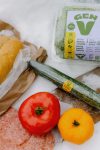
The recent announcement of increased tariffs on certain imported products from the U.S. could have a direct impact on our consumption habits. With rising grocery prices and the availability of some products, it’s more relevant than ever to prioritize local food. Fortunately, there are several solutions to adjust our shopping and support local producers.
Why Are These Tariffs Rising?
The tariffs imposed by the United States affect various agricultural and manufactured products. For Quebec consumers, this often translates into higher costs for fruits, vegetables, and other imported goods. While this situation can be challenging, it serves as a reminder of the importance of reducing our reliance on imports and supporting short supply chains.
5 Tips for Consuming Locally and Saving Money
1. Choose Greenhouse Vegetables
Luckily, we’re a greenhouse vegetable producer ourselves! But we’re not the only ones. Contrary to popular belief, many Quebec-grown vegetables are available year-round thanks to greenhouse cultivation. Cucumbers, lettuce, peppers, and tomatoes grown locally offer a fresh and tasty alternative to imported products.
2. Opt for Storage Vegetables or Go Back to Grandma's Cooking
In winter, storage vegetables like potatoes, carrots, beets, and squash are an excellent choice. Not only are they economical, but they also have a long shelf life and can be used to cook a variety of comforting dishes.
3. Eat According to the Seasons
Adapting to local harvests allows you to enjoy the best-priced and freshest products. In winter, focus on storage vegetables, greenhouse-grown items, and locally processed products, while in spring and summer, enjoy the small fruits and field-grown vegetables from Quebec, not forgetting the greenhouse producers who are available year-round, 365 days a year!
4. Buy from Local Markets and Farms
Many public markets and farms offer local product baskets, even in winter. By subscribing to a bio basket or visiting specialized grocery stores, you directly support the local economy while enjoying quality food.
5. Read Labels at the Grocery Store
Many local products can be found in large stores, but you need to know how to spot them. Look for labels such as “Produit du Québec” or “Aliments du Canada” on packaging to make informed choices. Additionally, you can check the origin directly on the labels.
A Positive Impact on the Economy and the Environment
Buying local is more than just an economic choice. It’s a concrete step that supports our farmers, reduces the carbon footprint associated with food transportation, and ensures better traceability of the products we consume.
In times of economic change, choosing local is a winning solution for our wallets and our planet.


